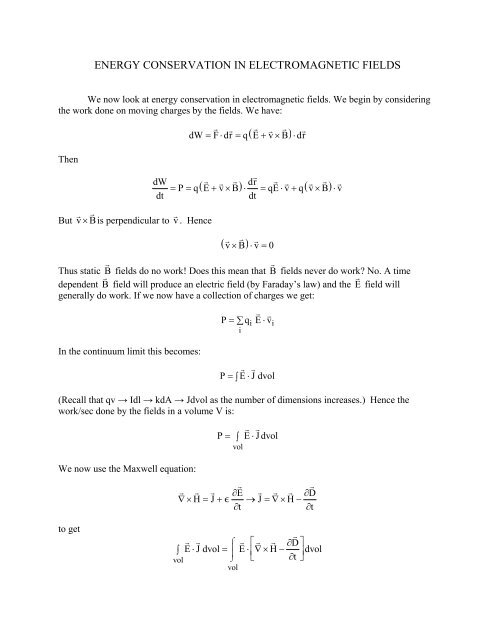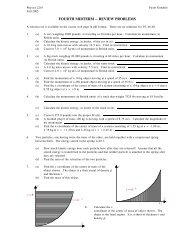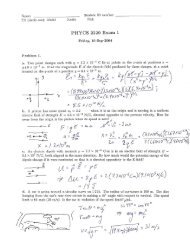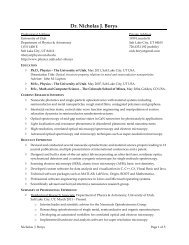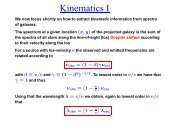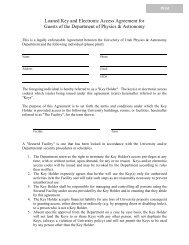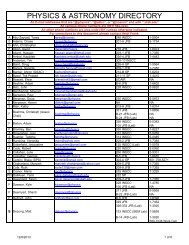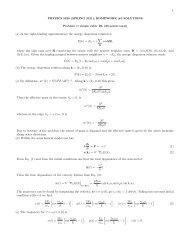ENERGY CONSERVATION IN ELECTROMAGNETIC FIELDS
ENERGY CONSERVATION IN ELECTROMAGNETIC FIELDS
ENERGY CONSERVATION IN ELECTROMAGNETIC FIELDS
Create successful ePaper yourself
Turn your PDF publications into a flip-book with our unique Google optimized e-Paper software.
<strong>ENERGY</strong> <strong>CONSERVATION</strong> <strong>IN</strong> <strong>ELECTROMAGNETIC</strong> <strong>FIELDS</strong><br />
We now look at energy conservation in electromagnetic fields. We begin by considering<br />
the work done on moving charges by the fields. We have:<br />
<br />
dW F dr q<br />
<br />
E v B<br />
<br />
dr<br />
Then<br />
dW <br />
<br />
<br />
<br />
<br />
dr <br />
P q EvB qEvq <br />
vB<br />
<br />
v<br />
dt<br />
dt<br />
<br />
But v B<br />
<br />
is perpendicular to v . Hence<br />
<br />
<br />
v B<br />
<br />
v0<br />
Thus static B fields do no work! Does this mean that B fields never do work? No. A time<br />
dependent B field will produce an electric field (by Faraday’s law) and the E field will<br />
generally do work. If we now have a collection of charges we get:<br />
P qi<br />
E <br />
vi<br />
i<br />
In the continuum limit this becomes:<br />
P E <br />
<br />
J dvol<br />
(Recall that qv → Idl → kdA → Jdvol as the number of dimensions increases.) Hence the<br />
work/sec done by the fields in a volume V is:<br />
We now use the Maxwell equation:<br />
P<br />
<br />
EJdvol<br />
vol<br />
<br />
<br />
E<br />
D<br />
H J,<br />
J H<br />
t<br />
t<br />
to get<br />
<br />
D<br />
<br />
E J dvol E H dvol<br />
t<br />
<br />
vol<br />
<br />
<br />
<br />
<br />
vol
But<br />
We know that<br />
<br />
<br />
<br />
<br />
vol<br />
<br />
EH E HE H<br />
<br />
<br />
<br />
<br />
D<br />
<br />
E J dvol H E E H E dvol<br />
vol<br />
vol <br />
t <br />
<br />
B<br />
D<br />
<br />
H E dvol E HdS<br />
t<br />
t<br />
<br />
<br />
<br />
<br />
<br />
surf<br />
<br />
D<br />
E dvol t<br />
is the rate at which energy is going into the electric field. Similarly:<br />
<br />
<br />
<br />
<br />
<br />
B<br />
H dvol t<br />
is the rate at which energy is going into the magnetic field. Thus:<br />
<br />
<br />
<br />
<br />
vol<br />
dU<br />
E J<br />
EM <br />
dvol <br />
E H<br />
<br />
dS<br />
t<br />
<br />
<br />
where U EM is the electromagnetic field energy/volume. The left hand side is then the rate at<br />
which energy is appearing in the volume V. Conservation of energy then requires that the right<br />
hand side be the rate at which energy is entering the volume. Thus we can interpret:<br />
<br />
S<br />
E<br />
H<br />
as the energy/sec/area carried by the electromagnetic field. S is called the “Poynting Vector”.<br />
As an example of its use consider a current I flowing through a resistor R.<br />
S
We know<br />
<br />
Vin<br />
Vout<br />
EL<br />
I<br />
zˆ<br />
<br />
R R<br />
The current will produce a magnetic field:<br />
<br />
B 0 I ˆ<br />
2 r<br />
directed as shown. Then:<br />
<br />
<br />
2<br />
B RI 0I<br />
ˆ RI<br />
SE zˆ<br />
rˆ<br />
L 2 r 2rL<br />
0 0<br />
Thus the energy entering the resistor/sec is:<br />
as expected!<br />
2<br />
S2rL<br />
I R


